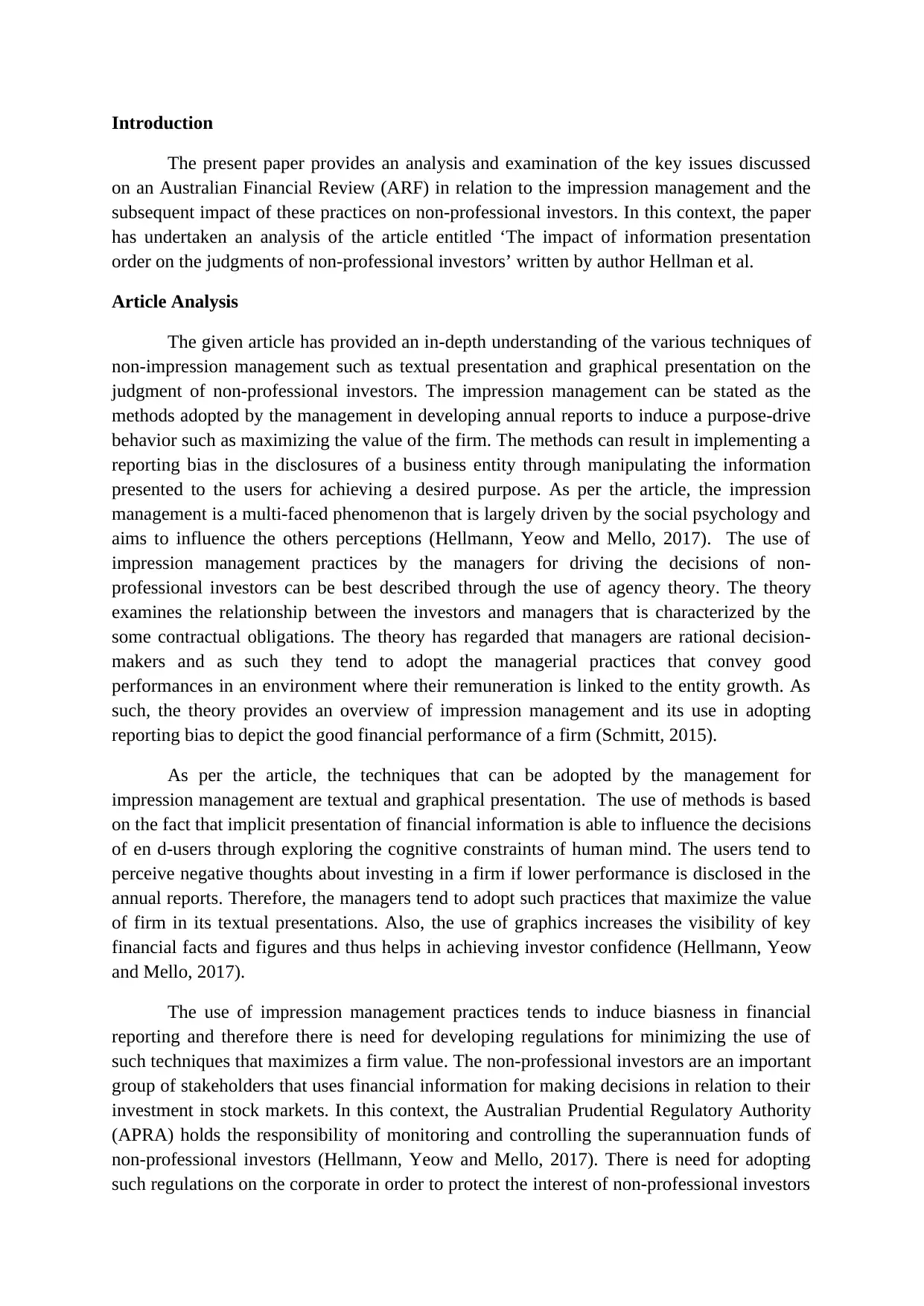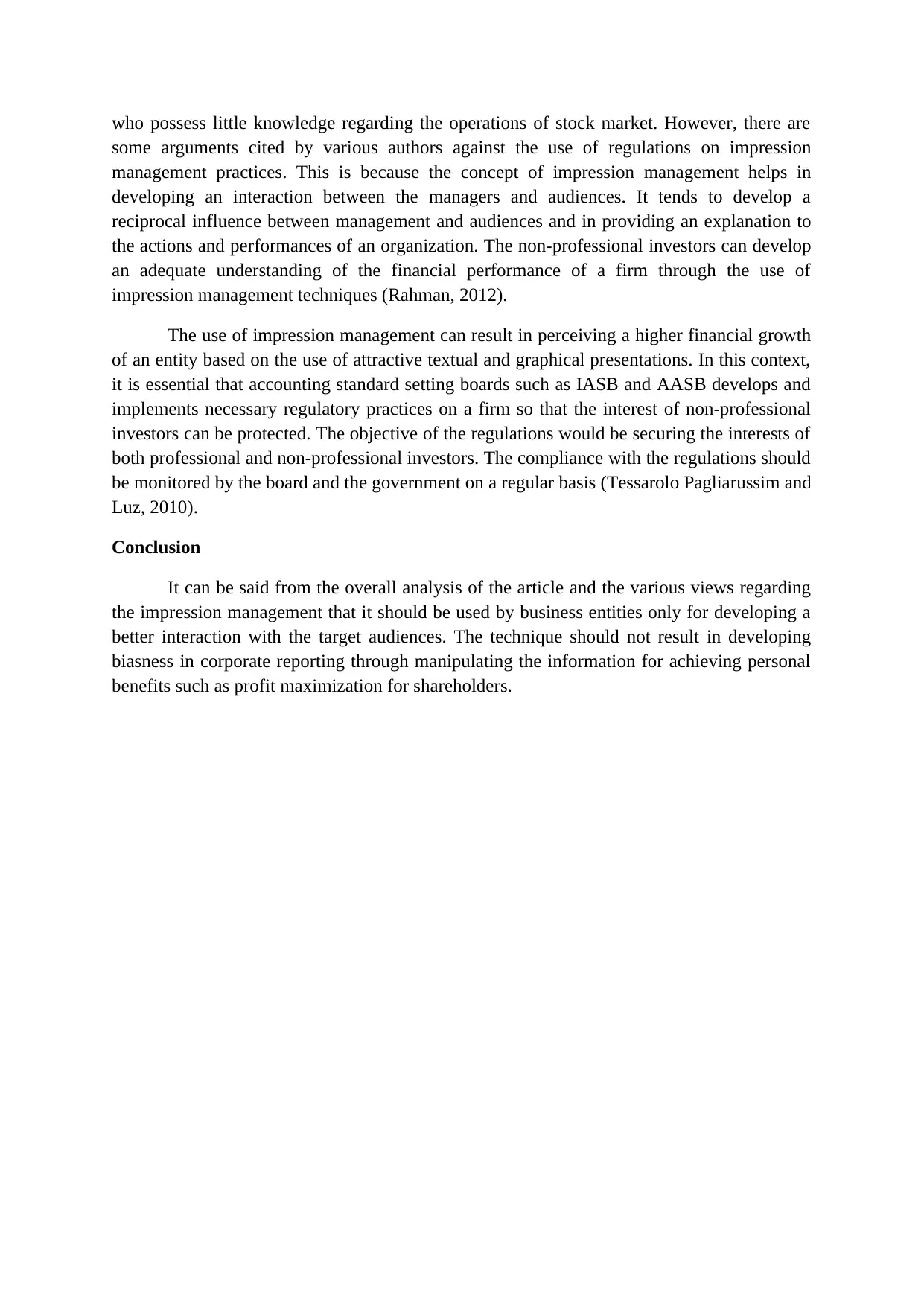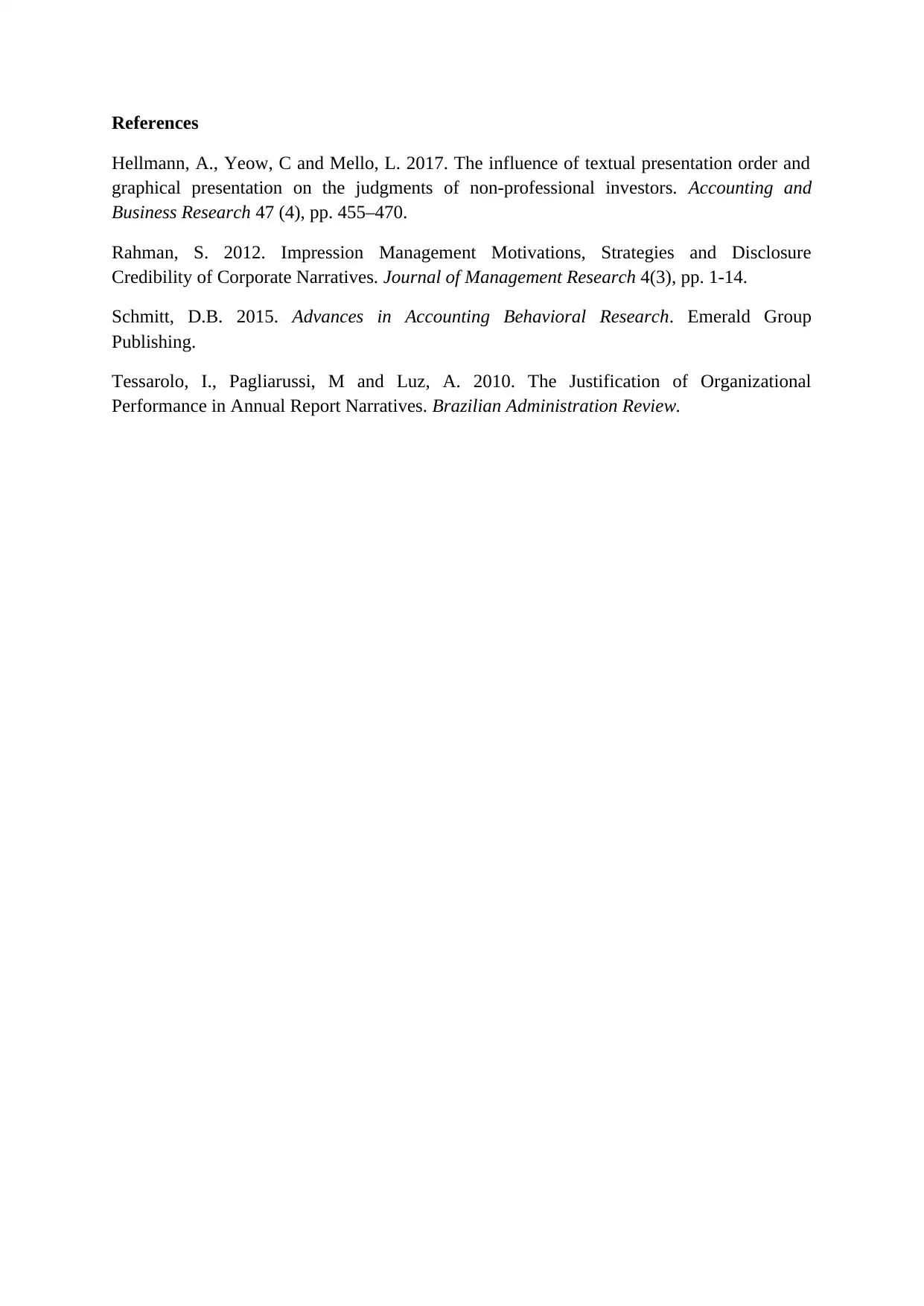Accounting in Context: Analysis of Impression Management Practices
VerifiedAdded on 2020/05/08
|4
|957
|66
Report
AI Summary
This report provides an analysis of impression management practices in accounting, focusing on an article from the Australian Financial Review. The paper examines how techniques like textual and graphical presentation influence non-professional investors, drawing on agency theory to explain managerial motivations. It discusses the role of regulatory bodies such as APRA, IASB, and AASB in minimizing reporting bias and protecting investor interests. The report highlights arguments for and against impression management, emphasizing the need for balanced regulations to ensure fair financial reporting and investor confidence. It concludes that impression management should facilitate interaction rather than manipulate information, promoting transparency and ethical practices in corporate disclosures.

Accounting in Context
Paraphrase This Document
Need a fresh take? Get an instant paraphrase of this document with our AI Paraphraser

Introduction
The present paper provides an analysis and examination of the key issues discussed
on an Australian Financial Review (ARF) in relation to the impression management and the
subsequent impact of these practices on non-professional investors. In this context, the paper
has undertaken an analysis of the article entitled ‘The impact of information presentation
order on the judgments of non-professional investors’ written by author Hellman et al.
Article Analysis
The given article has provided an in-depth understanding of the various techniques of
non-impression management such as textual presentation and graphical presentation on the
judgment of non-professional investors. The impression management can be stated as the
methods adopted by the management in developing annual reports to induce a purpose-drive
behavior such as maximizing the value of the firm. The methods can result in implementing a
reporting bias in the disclosures of a business entity through manipulating the information
presented to the users for achieving a desired purpose. As per the article, the impression
management is a multi-faced phenomenon that is largely driven by the social psychology and
aims to influence the others perceptions (Hellmann, Yeow and Mello, 2017). The use of
impression management practices by the managers for driving the decisions of non-
professional investors can be best described through the use of agency theory. The theory
examines the relationship between the investors and managers that is characterized by the
some contractual obligations. The theory has regarded that managers are rational decision-
makers and as such they tend to adopt the managerial practices that convey good
performances in an environment where their remuneration is linked to the entity growth. As
such, the theory provides an overview of impression management and its use in adopting
reporting bias to depict the good financial performance of a firm (Schmitt, 2015).
As per the article, the techniques that can be adopted by the management for
impression management are textual and graphical presentation. The use of methods is based
on the fact that implicit presentation of financial information is able to influence the decisions
of en d-users through exploring the cognitive constraints of human mind. The users tend to
perceive negative thoughts about investing in a firm if lower performance is disclosed in the
annual reports. Therefore, the managers tend to adopt such practices that maximize the value
of firm in its textual presentations. Also, the use of graphics increases the visibility of key
financial facts and figures and thus helps in achieving investor confidence (Hellmann, Yeow
and Mello, 2017).
The use of impression management practices tends to induce biasness in financial
reporting and therefore there is need for developing regulations for minimizing the use of
such techniques that maximizes a firm value. The non-professional investors are an important
group of stakeholders that uses financial information for making decisions in relation to their
investment in stock markets. In this context, the Australian Prudential Regulatory Authority
(APRA) holds the responsibility of monitoring and controlling the superannuation funds of
non-professional investors (Hellmann, Yeow and Mello, 2017). There is need for adopting
such regulations on the corporate in order to protect the interest of non-professional investors
The present paper provides an analysis and examination of the key issues discussed
on an Australian Financial Review (ARF) in relation to the impression management and the
subsequent impact of these practices on non-professional investors. In this context, the paper
has undertaken an analysis of the article entitled ‘The impact of information presentation
order on the judgments of non-professional investors’ written by author Hellman et al.
Article Analysis
The given article has provided an in-depth understanding of the various techniques of
non-impression management such as textual presentation and graphical presentation on the
judgment of non-professional investors. The impression management can be stated as the
methods adopted by the management in developing annual reports to induce a purpose-drive
behavior such as maximizing the value of the firm. The methods can result in implementing a
reporting bias in the disclosures of a business entity through manipulating the information
presented to the users for achieving a desired purpose. As per the article, the impression
management is a multi-faced phenomenon that is largely driven by the social psychology and
aims to influence the others perceptions (Hellmann, Yeow and Mello, 2017). The use of
impression management practices by the managers for driving the decisions of non-
professional investors can be best described through the use of agency theory. The theory
examines the relationship between the investors and managers that is characterized by the
some contractual obligations. The theory has regarded that managers are rational decision-
makers and as such they tend to adopt the managerial practices that convey good
performances in an environment where their remuneration is linked to the entity growth. As
such, the theory provides an overview of impression management and its use in adopting
reporting bias to depict the good financial performance of a firm (Schmitt, 2015).
As per the article, the techniques that can be adopted by the management for
impression management are textual and graphical presentation. The use of methods is based
on the fact that implicit presentation of financial information is able to influence the decisions
of en d-users through exploring the cognitive constraints of human mind. The users tend to
perceive negative thoughts about investing in a firm if lower performance is disclosed in the
annual reports. Therefore, the managers tend to adopt such practices that maximize the value
of firm in its textual presentations. Also, the use of graphics increases the visibility of key
financial facts and figures and thus helps in achieving investor confidence (Hellmann, Yeow
and Mello, 2017).
The use of impression management practices tends to induce biasness in financial
reporting and therefore there is need for developing regulations for minimizing the use of
such techniques that maximizes a firm value. The non-professional investors are an important
group of stakeholders that uses financial information for making decisions in relation to their
investment in stock markets. In this context, the Australian Prudential Regulatory Authority
(APRA) holds the responsibility of monitoring and controlling the superannuation funds of
non-professional investors (Hellmann, Yeow and Mello, 2017). There is need for adopting
such regulations on the corporate in order to protect the interest of non-professional investors

who possess little knowledge regarding the operations of stock market. However, there are
some arguments cited by various authors against the use of regulations on impression
management practices. This is because the concept of impression management helps in
developing an interaction between the managers and audiences. It tends to develop a
reciprocal influence between management and audiences and in providing an explanation to
the actions and performances of an organization. The non-professional investors can develop
an adequate understanding of the financial performance of a firm through the use of
impression management techniques (Rahman, 2012).
The use of impression management can result in perceiving a higher financial growth
of an entity based on the use of attractive textual and graphical presentations. In this context,
it is essential that accounting standard setting boards such as IASB and AASB develops and
implements necessary regulatory practices on a firm so that the interest of non-professional
investors can be protected. The objective of the regulations would be securing the interests of
both professional and non-professional investors. The compliance with the regulations should
be monitored by the board and the government on a regular basis (Tessarolo Pagliarussim and
Luz, 2010).
Conclusion
It can be said from the overall analysis of the article and the various views regarding
the impression management that it should be used by business entities only for developing a
better interaction with the target audiences. The technique should not result in developing
biasness in corporate reporting through manipulating the information for achieving personal
benefits such as profit maximization for shareholders.
some arguments cited by various authors against the use of regulations on impression
management practices. This is because the concept of impression management helps in
developing an interaction between the managers and audiences. It tends to develop a
reciprocal influence between management and audiences and in providing an explanation to
the actions and performances of an organization. The non-professional investors can develop
an adequate understanding of the financial performance of a firm through the use of
impression management techniques (Rahman, 2012).
The use of impression management can result in perceiving a higher financial growth
of an entity based on the use of attractive textual and graphical presentations. In this context,
it is essential that accounting standard setting boards such as IASB and AASB develops and
implements necessary regulatory practices on a firm so that the interest of non-professional
investors can be protected. The objective of the regulations would be securing the interests of
both professional and non-professional investors. The compliance with the regulations should
be monitored by the board and the government on a regular basis (Tessarolo Pagliarussim and
Luz, 2010).
Conclusion
It can be said from the overall analysis of the article and the various views regarding
the impression management that it should be used by business entities only for developing a
better interaction with the target audiences. The technique should not result in developing
biasness in corporate reporting through manipulating the information for achieving personal
benefits such as profit maximization for shareholders.
⊘ This is a preview!⊘
Do you want full access?
Subscribe today to unlock all pages.

Trusted by 1+ million students worldwide

References
Hellmann, A., Yeow, C and Mello, L. 2017. The influence of textual presentation order and
graphical presentation on the judgments of non-professional investors. Accounting and
Business Research 47 (4), pp. 455–470.
Rahman, S. 2012. Impression Management Motivations, Strategies and Disclosure
Credibility of Corporate Narratives. Journal of Management Research 4(3), pp. 1-14.
Schmitt, D.B. 2015. Advances in Accounting Behavioral Research. Emerald Group
Publishing.
Tessarolo, I., Pagliarussi, M and Luz, A. 2010. The Justification of Organizational
Performance in Annual Report Narratives. Brazilian Administration Review.
Hellmann, A., Yeow, C and Mello, L. 2017. The influence of textual presentation order and
graphical presentation on the judgments of non-professional investors. Accounting and
Business Research 47 (4), pp. 455–470.
Rahman, S. 2012. Impression Management Motivations, Strategies and Disclosure
Credibility of Corporate Narratives. Journal of Management Research 4(3), pp. 1-14.
Schmitt, D.B. 2015. Advances in Accounting Behavioral Research. Emerald Group
Publishing.
Tessarolo, I., Pagliarussi, M and Luz, A. 2010. The Justification of Organizational
Performance in Annual Report Narratives. Brazilian Administration Review.
1 out of 4
Your All-in-One AI-Powered Toolkit for Academic Success.
+13062052269
info@desklib.com
Available 24*7 on WhatsApp / Email
![[object Object]](/_next/static/media/star-bottom.7253800d.svg)
Unlock your academic potential
Copyright © 2020–2025 A2Z Services. All Rights Reserved. Developed and managed by ZUCOL.

